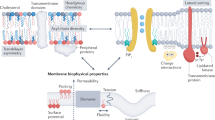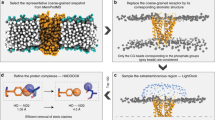Abstract
Macromolecular assemblies involving membrane proteins (MPs) serve vital biological roles and are prime drug targets in a variety of diseases1. Large-scale affinity purification studies of soluble-protein complexes have been accomplished for diverse model organisms, but no global characterization of MP-complex membership has been described so far. Here we report a complete survey of 1,590 putative integral, peripheral and lipid-anchored MPs from Saccharomyces cerevisiae, which were affinity purified in the presence of non-denaturing detergents. The identities of the co-purifying proteins were determined by tandem mass spectrometry and subsequently used to derive a high-confidence physical interaction map encompassing 1,726 membrane protein–protein interactions and 501 putative heteromeric complexes associated with the various cellular membrane systems. Our analysis reveals unexpected physical associations underlying the membrane biology of eukaryotes and delineates the global topological landscape of the membrane interactome.
This is a preview of subscription content, access via your institution
Access options
Subscribe to this journal
Receive 51 print issues and online access
$199.00 per year
only $3.90 per issue
Buy this article
- Purchase on Springer Link
- Instant access to full article PDF
Prices may be subject to local taxes which are calculated during checkout




Similar content being viewed by others
References
Bao, L., Redondo, C., Findlay, J. B., Walker, J. H. & Ponnambalam, S. Deciphering soluble and membrane protein function using yeast systems. Mol. Membr. Biol. 26, 127–135 (2009)
Miller, J. P. et al. Large-scale identification of yeast integral membrane protein interactions. Proc. Natl Acad. Sci. USA 102, 12123–12128 (2005)
Tarassov, K. et al. An in vivo map of the yeast protein interactome. Science 320, 1465–1470 (2008)
Costanzo, M. et al. The genetic landscape of a cell. Science 327, 425–431 (2010)
Turner, B. et al. iRefWeb: interactive analysis of consolidated protein interaction data and their supporting evidence. Database (Oxford). 2010, baq023 (2010)
Gavin, A. C. et al. Proteome survey reveals modularity of the yeast cell machinery. Nature 440, 631–636 (2006)
Krogan, N. J. et al. Global landscape of protein complexes in the yeast Saccharomyces cerevisiae . Nature 440, 637–643 (2006)
Ghaemmaghami, S. et al. Global analysis of protein expression in yeast. Nature 425, 737–741 (2003)
Babu, M., Krogan, N. J., Awrey, D. E., Emili, A. & Greenblatt, J. F. Systematic characterization of the protein interaction network and protein complexes in Saccharomyces cerevisiae using tandem affinity purification and mass spectrometry. Methods Mol. Biol. 548, 187–207 (2009)
Collins, S. R. et al. Toward a comprehensive atlas of the physical interactome of Saccharomyces cerevisiae . Mol. Cell. Proteomics 6, 439–450 (2007)
Pu, S., Wong, J., Turner, B., Cho, E. & Wodak, S. J. Up-to-date catalogues of yeast protein complexes. Nucleic Acids Res. 37, 825–831 (2009)
de Godoy, L. M. et al. Comprehensive mass-spectrometry-based proteome quantification of haploid versus diploid yeast. Nature 455, 1251–1254 (2008)
Ostlund, G. et al. InParanoid 7: new algorithms and tools for eukaryotic orthology analysis. Nucleic Acids Res. 38, D196–D203 (2010)
Mewes, H. W. et al. MIPS: analysis and annotation of proteins from whole genomes in 2005. Nucleic Acids Res. 34, D169–D172 (2006)
Reguly, T. et al. Comprehensive curation and analysis of global interaction networks in Saccharomyces cerevisiae . J. Biol. 5, 11 (2006)
Yu, H. et al. High-quality binary protein interaction map of the yeast interactome network. Science 322, 104–110 (2008)
Pu, S., Vlasblom, J., Emili, A., Greenblatt, J. & Wodak, S. J. Identifying functional modules in the physical interactome of Saccharomyces cerevisiae . Proteomics 7, 944–960 (2007)
Aguilar, P. S. et al. A plasma-membrane E-MAP reveals links of the eisosome with sphingolipid metabolism and endosomal trafficking. Nature Struct. Mol. Biol. 17, 901–908 (2010)
Schuldiner, M. et al. Exploration of the function and organization of the yeast early secretory pathway through an epistatic miniarray profile. Cell 123, 507–519 (2005)
Collins, S. R. et al. Functional dissection of protein complexes involved in yeast chromosome biology using a genetic interaction map. Nature 446, 806–810 (2007)
Enright, A. J., Van Dongen, S. & Ouzounis, C. A. An efficient algorithm for large-scale detection of protein families. Nucleic Acids Res. 30, 1575–1584 (2002)
Flinn, R. J. & Backer, J. M. mTORC1 signals from late endosomes: taking a TOR of the endocytic system. Cell Cycle 9, 1869–1870 (2010)
Paumi, C. M. et al. Mapping protein-protein interactions for the yeast ABC transporter Ycf1p by integrated split-ubiquitin membrane yeast two-hybrid analysis. Mol. Cell 26, 15–25 (2007)
Renard, H. F., Demaegd, D., Guerriat, B. & Morsomme, P. Efficient ER exit and vacuole targeting of yeast Sna2p require two tyrosine-based sorting motifs. Traffic 11, 931–946 (2010)
Page, L. J., Sowerby, P. J., Lui, W. W. & Robinson, M. S. γ-synergin: an EH domain-containing protein that interacts with γ-adaptin. J. Cell Biol. 146, 993–1004 (1999)
Pieper, U. et al. ModBase, a database of annotated comparative protein structure models, and associated resources. Nucleic Acids Res. 39, D465–D474 (2011)
Sato, K. & Nakano, A. Emp47p and its close homolog Emp46p have a tyrosine-containing endoplasmic reticulum exit signal and function in glycoprotein secretion in Saccharomyces cerevisiae . Mol. Biol. Cell 13, 2518–2532 (2002)
Sidhu, R. S., Mathewes, S. & Bollon, A. P. Selection of secretory protein-encoding genes by fusion with PHO5 in Saccharomyces cerevisiae . Gene 107, 111–118 (1991)
Zhang, B. Recent developments in the understanding of the combined deficiency of FV and FVIII. Br. J. Haematol. 145, 15–23 (2009)
Rose, M. D., Winston, F. & Hieter, P. Methods in Yeast Genetics (Cold Spring Harbor Laboratory Press, 1990)
Conibear, E. & Stevens, T. H. Studying yeast vacuoles. Methods Enzymol. 351, 408–432 (2002)
Li, Z. et al. Systematic exploration of essential yeast gene function with temperature-sensitive mutants. Nature Biotechnol. 29, 361–367 (2011)
Gelperin, D. M. et al. Biochemical and genetic analysis of the yeast proteome with a movable ORF collection. Genes Dev. 19, 2816–2826 (2005)
Valdivia, R. H. & Schekman, R. The yeasts Rho1p and Pkc1p regulate the transport of chitin synthase III (Chs3p) from internal stores to the plasma membrane. Proc. Natl Acad. Sci. USA 100, 10287–10292 (2003)
Lam, K. K. et al. Palmitoylation by the DHHC protein Pfa4 regulates the ER exit of Chs3. J. Cell Biol. 174, 19–25 (2006)
James, P., Halladay, J. & Craig, E. A. Genomic libraries and a host strain designed for highly efficient two-hybrid selection in yeast. Genetics 144, 1425–1436 (1996)
Snider, J. et al. Detecting interactions with membrane proteins using a membrane two-hybrid assay in yeast. Nature Protocols 5, 1281–1293 (2010)
Acknowledgements
We thank H. Riezman, K. Sato and A. Nakano for providing strains and reagents, C. Ungermann for Sec18 antisera, A. Pierleoni for assistance with MemPype and R. Zheng for technical assistance. This research was supported by grants from the Canadian Foundation for Innovation, the Canadian Institutes of Health Research (CIHR MOP no. 81156, MOP no. 64394 and MOP no. 82940), the Canadian Cancer Society Research Institute, the Heart and Stroke Foundation, the Cystic Fibrosis Foundation, Novartis, the Ontario Genomics Institute and Genome Canada. E.C. is a CIHR New Investigator. S.J.W. is a Canada Research Chair Tier-I and acknowledges support from the SickKids Foundation.
Author information
Authors and Affiliations
Contributions
J.F.G., A.E. and M.B. designed the project. M.B. coordinated and managed all experiments, and data analysis was coordinated by J.V. with guidance from S.J.W. and M.B. X.G., O.H., G.Z. and J.L. prepared the purification samples. S.C., N.B. and C.C. carried out mass spectrometry. V.F., T.P. and S.P. (CCBR) performed database searches and curation. J.V. and S.P. (CCBR) designed the web portal. J.V., M.B. and S.P. (SickKids) analysed the network data. M.B., C.G., B.D.M.B., J.S., V.W., A.Y., Y.Y.C.T., H.E.B., M.D. and F.J.V. carried out validation experiments. M.B., J.V., E.C., S.J.W. and A.E. jointly drafted the manuscript with critical input from J.F.G., and contributions from I.S., J.S. and B.D.M.B. All authors discussed the results and commented on the manuscript.
Corresponding authors
Ethics declarations
Competing interests
The authors declare no competing financial interests.
Supplementary information
Supplementary Information
This file contains Supplementary Text and Data, Supplementary References, legends for Supplementary Tables 1-13 (see separate zipped file) and Supplementary Figures 1-7. (PDF 1327 kb)
Supplementary Tables
This file contains Supplementary Tables 1-9 (see Supplementary Information file for legends). (ZIP 11552 kb)
Rights and permissions
About this article
Cite this article
Babu, M., Vlasblom, J., Pu, S. et al. Interaction landscape of membrane-protein complexes in Saccharomyces cerevisiae. Nature 489, 585–589 (2012). https://doi.org/10.1038/nature11354
Received:
Accepted:
Published:
Issue Date:
DOI: https://doi.org/10.1038/nature11354
This article is cited by
-
Co-fractionation–mass spectrometry to characterize native mitochondrial protein assemblies in mammalian neurons and brain
Nature Protocols (2023)
-
An exhaustive review of computational prediction techniques for PPI sites, protein locations, and protein functions
Network Modeling Analysis in Health Informatics and Bioinformatics (2023)
-
Analysis of transient membrane protein interactions by single-molecule diffusional mobility shift assay
Experimental & Molecular Medicine (2021)
-
Membrane phospholipid alteration causes chronic ER stress through early degradation of homeostatic ER-resident proteins
Scientific Reports (2019)
-
Clathrin Adaptor Complex-interacting Protein Irc6 Functions through the Conserved C-Terminal Domain
Scientific Reports (2019)
Comments
By submitting a comment you agree to abide by our Terms and Community Guidelines. If you find something abusive or that does not comply with our terms or guidelines please flag it as inappropriate.



